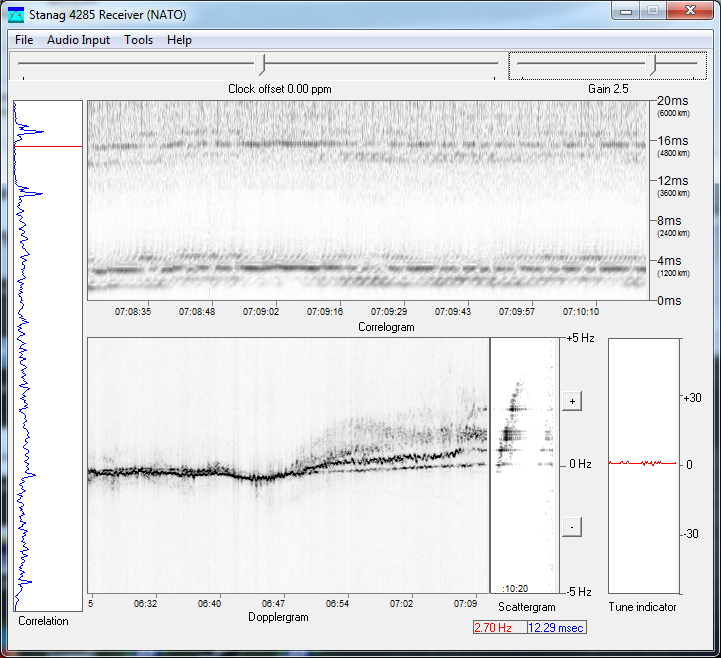,
which shows frequency variations in the received signal. In this
example, recorded at about sunrise, there are several frequency
products visible. At the right of this pane, you see (as the lowest line) the E-layer response, and
above that the F1 and F2 responses, followed by double-hop F1 and F2
responses, plus scatter. The double-hop returns are generally only
seen at sunrise, and represent rays of the signal that have been
returned from the F layer, bounced off the earth, then again returned
by the F layer. These are characterised by double the Doppler shift
of the main F layer returns, and are weaker due to loss, particularly
on reflection from the earth. The height of the Dopplergram is ±5
Hz, and the Dopplergram moves along in time, with time marked
underneath.
Scattergram
To
the right of the Dopplergram is the Scattergram,
which is a unique combination of frequency and timing, and slowly
changes with time. As you can see, the vertical axis of the
Scattergram exactly matches that of the Dopplergram, and shows
(averaged) the exact same frequency effects seen on the latter. The
horizontal axis of the Scattergram is propagation time. Zero at the left and
about 16 ms on the right, so you can easily read off the additional
time-of-flight and frequency shift of the various products with
remarkable precision (0.25 ms and 0.04 Hz resolution).
In the example picture above, there is a
whole line of products stretching up in frequency as far as +3 Hz,
and +10 ms. For the first time, we can recognise and measure these
individual products. Note how the individual dots are roughly in a straight
line and some are very sharp. The increase in frequency is caused by
Doppler shift, as at sunrise the apparent height of each layer moves
closer to earth with increasing refractive index (ion density). Below
the Scattergram is a small box, in which the frequency offset and
delay are indicated when the mouse is hovered over a point on the
Scattergram.
Here are two examples of Scattergrams of the same station on 4.5 MHz, morning and evening, at a range of about 1000 km. The ionosphere is much more disturbed
in the evening after being stimulated all day, which causes increased scatter (looks like noise). It settles down overnight.
The first picture was captured at sunrise, the second at sunset.


Sunrise Sunset
In the first picture you can clearly see the E-layer return (sharp dot with least delay) other minor dots, (possibly reflections off aircraft), then two
strong dots, which are the F1 and F2 returns, followed by another two, which are double-hop F1 and F2. These have double the shift because they have been returned
twice from the ionosphere and of course have increased delay. The dots are in a line of increasing frequency, as the active height of the layers is reducing
with increasing ion density and therefore increasing refractive index.
In the evening the E and F returns are strong, and there are scattered (and therefore indistinct) returns from the F layer, probably from points not
on the direct path. The dots and scatter are in a line of decreasing frequency, as the active height of the layers is increasing
as the charged ions slowly disippate.
It is important to use a very stable synthesised receiver and a good antenna to achieve results like this. The Scattergrams are only 10 Hz high.

